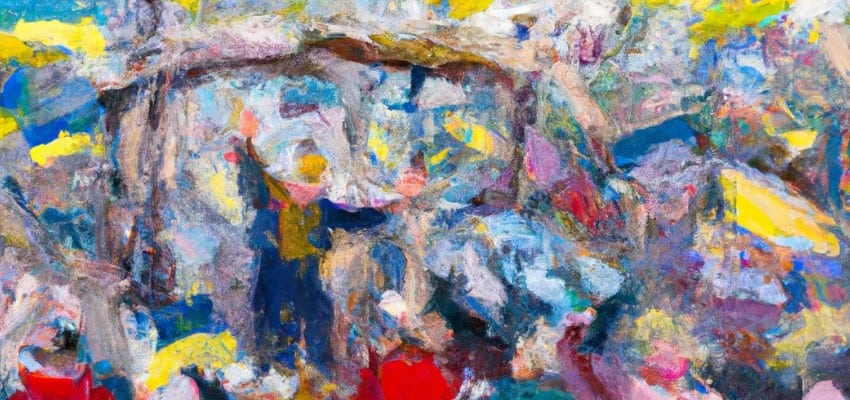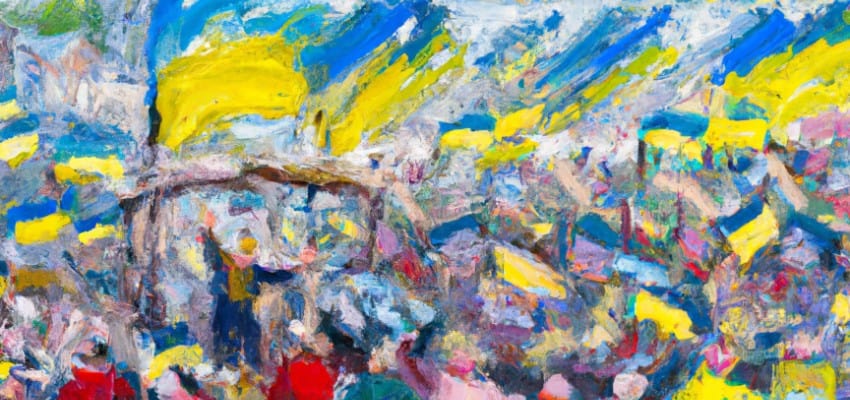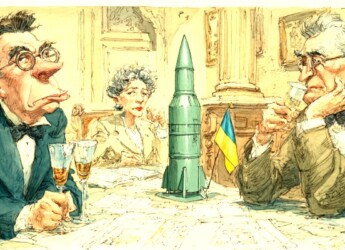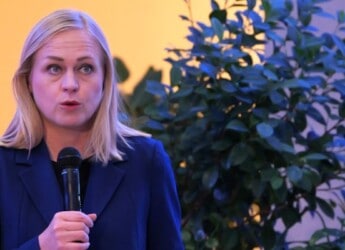|
|
Content Assessment: A Liberating Momentum? Ukraine Conflict Assessments in Maps (November 7-13, 2022)
Information - 95%
Insight - 94%
Relevance - 93%
Objectivity - 94%
Authority - 93%
94%
Excellent
A short percentage-based assessment of the qualitative benefit of the post highlighting the recent Ukraine conflict assessments in maps from the Institute for the Study of War.
Editor’s Note: One of the most accurate and detailed sources for ongoing updates on the Ukraine crisis is the Ukraine Conflict Update from the Institute for the Study of War. The Institute for the Study of War (ISW) is a 501(c)(3) organization and produces strictly non-partisan, non-ideological, fact-based research. ISW seeks to promote an informed understanding of war and military affairs through comprehensive, independent, and accessible open-source research and analysis. ISW’s research is made available to the general public, military practitioners, policymakers, and media members. Providing a daily synthesis of key events related to the Russian aggression against Ukraine, ISW updates may benefit cybersecurity, information governance, and legal discovery professionals as they follow the business, information technology, and legal trends and trajectories impacted by and stemming from the current Ukraine conflict.
Assessment and Maps*
Ukraine Conflict Assessments – An Overview in Maps
- Institute for the Study of War (ISW), Russia Team
- Critical Threats Project (CTP), American Enterprise Institute
General Assessment Background Info
- ISW systematically publishes Russian campaign assessments that include maps highlighting the assessed control of terrain in Ukraine and main Russian maneuver axes.
- These maps augment daily synthetic products that cover key events related to renewed Russian aggression against Ukraine.
The Russian Offensive Campaign Assessments
- November 13, 2022
- By Frederick W. Kagan
Key Development
- The Russians are not setting conditions for a relaxation of hostilities for the rest of the fall and into the winter but rather are launching a new offensive in Donetsk Oblast. The Ukrainians will likely use combat power recouped from the liberation of western Kherson to reinforce their ongoing counter-offensive in Luhansk Oblast or to open a new counter-offensive drive elsewhere. This is not the time to slow down aid or press for ceasefires or negotiations, but rather the time to help Ukraine take advantage of its momentum in conditions that favor Kyiv rather than Moscow.
Key Takeaways
- Wagner Group Financer Yevgeny Prigozhin asked the Russian Prosecutor General’s Office to open a case against St. Petersburg Governor Alexander Beglov for high treason amid viral footage of Wagner forces murdering one of their own.[19] Prigozhin and Russian nationalist milbloggers largely supported the murder of the alleged traitor.
- The Russian military grouping stationed in Belarus continues to generate social tensions among Belarusians.
- Russian sources claimed that Ukrainian forces continued counteroffensive operations in the direction of Kreminna and Svatove.
- Ukrainian forces continued to consolidate control over the right bank of the Dnipro River in Kherson Oblast. Ukrainian forces struck a Russian military base in Chaplynka, Kherson Oblast, 50km south of Beryslav on the eastern bank of the Dnipro.
- Russian forces continued to conduct offensive operations in the directions of Bakhmut, Avdiivka, and Vuhledar. The Russian Ministry of Defense claimed that Russian forces captured Mayorsk, southeast of Bakhmut.
- Russian forces continued routine indirect fire against frontline settlements in Zaporizhia and Dnipropetrovsk oblasts. Russian forces struck Zaporizhzhia City with an Iskander missile.
- Kremlin spokesperson Dmitry Peskov announced that Russian President Vladimir Putin ordered the demobilization of mobilized students in Russian-occupied Luhansk and Donetsk oblasts, likely as part of an ongoing effort to integrate proxy forces into the Russian Armed Forces.
- Russian forces and occupation officials are forcibly mobilizing men in Russian-occupied Melitopol, Zaporizhia Oblast, and forcing them to construct trenches and defensive fortifications in the city.
- Ukrainian officials stated that Russian forces are withdrawing from the left bank of the Dnipro River and concentrating forces and equipment in Melitopol, Zaporizhia Oblast, and Mariupol, Donetsk Oblast.
- Russian President Vladimir Putin proposed an amendment to a draft law that would allow Russian officials to revoke Russian citizenship for disseminating “false” information about the Russian military, participating in extremist or undesirable organizations, or calling for violations of Russian “territorial integrity.”
- November 12, 2022
- By Kateryna Stepanenko, Grace Mappes, Riley Bailey, Angela Howard, and Frederick W. Kagan
Key Development
- Russia’s withdrawal from Kherson City is igniting an ideological fracture between pro-war figures and Russian President Vladimir Putin, eroding confidence in Putin’s commitment and ability to deliver his war promises.
Key Takeaways
- Russia’s withdrawal from Kherson City is igniting an ideological fracture between pro-war figures and Russian President Vladimir Putin, eroding confidence in Putin’s commitment to and ability to deliver on his war promises.
- Russian officials are increasingly normalizing the public and likely illegal deportation of thousands of Ukrainian children to Russia.
- The Russian military leadership is trying and failing to integrate ad hoc military formations into a more cohesive fighting force in Ukraine.
- Russian sources claimed that Ukrainian forces continued counteroffensive operations in the direction of Kreminna and Svatove.
- Ukrainian forces continued to liberate settlements on the right (western) bank of the Dnipro River in Kherson Oblast.
- Russian forces continued offensive operations in the direction of Bakhmut, Avdiivka, and Vuhledar.
- Russian officials may be trying to avoid providing military personnel with promised payments.
- Russian forces and occupation officials continue to endanger residents and subject them to coercive measures.
- November 11, 2022
- By Karolina Hird, Grace Mappes, Riley Bailey, Kateryna Stepanenko, and Frederick W. Kagan
Key Development
- Ukrainian forces are completing the liberation of the western (right) bank of Kherson Oblast after the Russians retreated from it.
Key Takeaways
- Ukrainian forces are completing the liberation of the western (right) bank of the Dnipro River in Kherson Oblast.
- Ukrainian troops have made major territorial gains throughout Kherson Oblast on November 11 and will continue consolidating control of the western bank in the coming days.
- Russian milbloggers criticized the Russian MoD’s statements about the Russian withdrawal to the left bank but generally took a more muted attitude to Ukrainian gains.
- Russian sources claimed that Ukrainian forces continued counteroffensive operations towards Kreminna and Svatove, Luhansk Oblast, and Ukrainian forces targeted Russian logistics in rear Luhansk Oblast.
- Russian forces continued ground assaults around Bakhmut, Avdiivka, and Vuhledar.
- Ukrainian forces continued to target Russian force concentrations in Zaporizhia Oblast.
- Wagner Group financer Yevgeny Prigozhin continued to form parallel military structures in Belgorod and Kursk oblasts, even though there is no threat of a Ukrainian ground invasion into Russian territory.
- The Russian Ministry of Defense’s (MoD) subpar conduct of partial mobilization continues to generate social tension.
- Ukrainian partisans continued to target Russian occupation authorities.
- November 10, 2022
- By Karolina Hird, Kateryna Stepanenko, Riley Bailey, Yekaterina Klepanchuk, Katherine Lawlor, and Mason Clark
Key Development
- Ukrainian forces steadily advanced in Kherson Oblast on November 10 as Russian forces conduct a withdrawal to the east (left) bank of the Dnipro River.
Key Takeaways
- Ukrainian forces steadily advanced in Kherson Oblast on November 10 as Russian forces conduct a withdrawal to the east (left) bank of the Dnipro River.
- The Russian withdrawal will take some time to complete, and fighting will continue throughout Kherson Oblast as Ukrainian troops advance and come up against pre-prepared Russian defensive lines, especially around Kherson City.
- ISW does not assess the fighting in Ukraine will halt or enter a stalemate due to winter weather, despite faulty Western assumptions.
- Ukraine holds the initiative and is in the process of securing a major victory in Kherson. A ceasefire would provide the Kremlin with the pause it desperately needs to reconstitute Russian forces.
- Wagner Group financier Yevgeniy Prigozhin is increasingly wrestling with St. Petersburg officials over expanding Wagner Group recruitment in the city.
- Ukrainian Air Force Command spokesperson Yuriy Ignat stated that Russian force will likely slow the pace of their campaign against Ukrainian infrastructure.
- Ukrainian forces continued to conduct counteroffensive operations on the Svatove-Kreminna line.
- Russian forces continued offensive operations near Bakhmut, Avdiivka, and in western Donetsk.
- Russian forces began constructing second line fortifications in Crimea and southern Ukraine.
- Russian citizens continue to oppose Russia’s war in Ukraine through protest, social media dissent, and desertions from the military.
- Russian mobilization efforts are channeling personnel to the Wagner group.
- Russian occupation officials are continuing efforts to erode Ukrainian national identity while mobilizing residents in Russian-occupied territories.
- November 9, 2022
- By Karolina Hird, Grace Mappes, Kateryna Stepanenko, Madison Williams, Yekaterina Klepanchuk, Nicholas Carl, and Mason Clark
Key Development
- The Ukrainian counteroffensive in the Kherson direction since August—a coordinated interdiction campaign to force Russian forces to withdraw across the Dnipro without necessitating major Ukrainian ground offensives—has likely succeeded.
Key Takeaways
- The Russian Ministry of Defense (MoD) ordered Russian forces on the west (right) bank of the Dnipro River to begin withdrawing to the east (left) bank on November 9.
- The battle of Kherson is not inherently over, but Russian forces have entered a new phase— prioritizing withdrawing their forces across the river in good order and delaying Ukrainian forces, rather than seeking to halt the Ukrainian counteroffensive entirely.
- Many prominent voices in the Russian milblogger space sided with Surovikin and lauded the decision as a necessary one, indicating that Russian leadership has learned from the information effects of the disastrous Russian withdrawal from Kharkiv Oblast in mid-September.
- Russian National Security Council Secretary Nikolai Patrushev met with senior Iranian officials in Tehran on November 9, likely to discuss the sale of Iranian ballistic missiles to Russia and other forms of cooperation
- Russian and Ukrainian sources reported continued fighting along the Svatove-Kremmina highway and Bilohorivka, Luhansk Oblast.
- Ukrainian forces made territorial gains northeast of Kherson City and continued their successful interdiction campaign.
- Russian forces continued offensive operations around Bakhmut, Avdiivka, and in western Donetsk Oblast.
- Russian federal subjects are struggling to pay mobilized personnel, and the Russian military is struggling to provision them.
- Relatives of mobilized personnel continue to protest lack of payment and poor conditions.
- Russian occupation deputy head of Kherson Oblast Kirill Stremousov was killed in a claimed car accident in rear Kherson Oblast the day Russian forces announced their withdrawal from the west bank of Kherson Oblast.
- Occupation authorities in rear areas are likely increasing law enforcement crackdowns and filtration measures amid fears of Ukrainian counteroffensives after the November 9 withdrawal announcement.
- November 8, 2022
- By Karolina Hird, Grace Mappes, Madison Williams, Yekaterina Klepanchuk, Nicholas Carl, and Mason Clark
Key Development
- Iranian state-run outlet Nour News Agency reported that Russian National Security Council Secretary Nikolai Patrushev arrived in Tehran on November 8, likely to discuss the potential sale of Iranian ballistic missiles to Russia.
Key Takeaways
- Iranian sources announced—without Russian confirmation—that Russian National Security Council Secretary Nikolai Patrushev arrived in Tehran on November 8, likely to discuss the potential sale of Iranian ballistic missiles to Russia. Iran likely announced Patrushev’s arrival to highlight the deepening cooperation between Moscow and Tehran to an international audience, as well as to implicitly highlight that a high-ranking Russian official turned to Iran for help in Ukraine.
- Wagner Group forces are continuing to exaggerate their claimed territorial gains in Donbas to further distinguish themselves from proxy and conventional Russian forces.
- Ukrainian forces likely made marginal gains northwest of Svatove, Luhansk Oblast, and Russian sources claimed that Ukrainian forces intensified offensive operations toward Kreminna.
- Russian forces continued offensive operations around Bakhmut, Avdiivka, and in western Donetsk Oblast.
- Ukrainian authorities attempted to counteract Russian authorities’ continued efforts to strengthen control of the Zaporizhzhia Nuclear Power Plant (ZNPP).
- The disproportionate financial burden of Russian force generation efforts continues to fall primarily on Russian regional governments’ budgets, prompting public backlash.
- Financial and bureaucratic issues are continuing to hinder Russian efforts to replenish formerly elite units defending critical areas of the front line, potentially threatening the integrity of Russian defenses in occupied parts of Ukraine.
- Russian occupation authorities in Kherson Oblast may be trying to force residents out of the western part of the oblast by cutting communications on the west bank of the Dnipro River.
- November 7, 2022
- By Karolina Hird, Kateryna Stepanenko, Grace Mappes, Riley Bailey, Madison Williams, and Mason Clark
Key Development
- The Russian MoD has remained remarkably tight-lipped about milblogger critiques of Russian failures throughout the war in Ukraine — unlike the Kremlin, which will occasionally indirectly address milblogger narratives. The MoD’s public response to milblogger outcry indicates that some Russian milbloggers have considerable leverage to shape MoD interactions in the information space and additionally suggests that the situation in Pavlivka is dire enough to warrant a response.
Key Takeaways
- The Russian Ministry of Defense (MoD) issued a rare statement on November 7 in response to extensive Russian milblogger outcry about reported extensive losses and poor command within the 155th Naval Infantry Brigade of the Pacific Fleet.
- The Russian pro-war siloviki faction (including Yevgeny Prigozhin and Ramzan Kadyrov) is increasing its influence in part to advance personal interests in Russia and occupied Ukraine, not strictly to win the war.
- Russian forces have greatly depleted their arsenal of high-precision weapons systems and have suffered significant aviation losses and will likely struggle to maintain the current pace of the Russian military’s coordinated campaign against Ukrainian critical infrastructure.
- Russian occupation authorities likely began a new phase of evacuations from Kherson Oblast.
- Russian troops continued efforts to fix Ukrainian troops against the international border in northeastern Kharkiv Oblast.
- Russian sources claimed that Ukrainian troops continued counteroffensive operations in the Svatove direction.
- Russian sources claimed that Russian troops conducted limited counterattacks to regain lost positions west of Kreminna.
- Russian sources widely claimed that proxy and Wagner Group troops entered the outskirts of Bilohorivka.
- Russian sources reported that Ukrainian troops are massing in the Kherson Oblast direction.
- Russian troops continued offensive operations around Bakhmut, in the Avdiivka-Donetsk City area, and in western Donetsk Oblast.
- Ukrainian forces conducted limited interdiction efforts against Russian concentration areas in Zaporizhzhia Oblast.
- Russian President Vladimir Putin continued to make public statements and signed additional decrees to portray himself as taking steps to fix fundamental problems with partial mobilization in Russia.
- Russian and occupation officials continue to abduct Ukrainian children, intimidate civilians, and escalate filtration measures.
We do not report in detail on Russian war crimes because those activities are well-covered in Western media and do not directly affect the military operations we are assessing and forecasting. We will continue to evaluate and report on the effects of these criminal activities on the Ukrainian military and population and specifically on combat in Ukrainian urban areas. We utterly condemn these Russian violations of the laws of armed conflict, Geneva Conventions, and humanity even though we do not describe them in these reports.
Chronology of Maps from November 7-13, 2022 – Mouseover to Scroll
Ukraine Conflict Maps - 110722-111322See the Institute for the Study of War Interactive Map of the Russian Invasion
Read the latest Ukraine Conflict updates from the Institute for the Study of War
* Shared with direct express permission from the Institute for the Study of War (ISW).
About the Institute for the Study of War Research Methodology
ISW’s research methodology relies on both primary and secondary sources, enabling researchers to develop a comprehensive understanding of the situation on the ground. In order to analyze military and political developments in any given area, ISW’s research analysts must wholly understand the systems of enemy and friendly forces. They must also understand the population demographics, physical terrain, politics, and history of that area. This lays the analytical foundation for understanding the reasons for particular developments and fulfilling their assigned research objectives. ISW analysts also spend time in places like Iraq, Afghanistan, and elsewhere in order to gain a better understanding of the security and political situation and to evaluate the implementation of current strategies and policies. Our researchers compile data and analyze trends, producing a granular analysis of developments in areas of research, producing an accurate, high-resolution, timely, and thorough picture of the situation. ISW’s research methodology guarantees its success and commitment to improving the nation’s ability to execute military operations, achieve strategic objectives, and respond to emerging problems that may require the use of American military power.
About the Institute for the Study of War
The Institute for the Study of War advances an informed understanding of military affairs through reliable research, trusted analysis, and innovative education. We are committed to improving the nation’s ability to execute military operations and respond to emerging threats in order to achieve U.S. strategic objectives. ISW is a non-partisan, non-profit, public policy research organization.
Learn more, get involved, and contribute today.
Additional Reading
- [Annual Update] International Cyber Law in Practice: Interactive Toolkit
- Data Embassies: Sovereignty, Security, and Continuity for Nation-States
Source: ComplexDiscovery



























